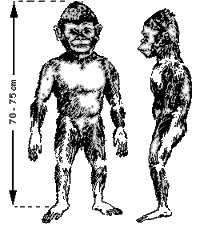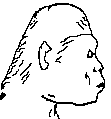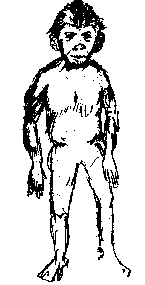The Other Orang: The Orang Pendek
It has a man's face and a gorilla's torso. Officially, it doesn't exist, but try telling that to the people who've met it. Debbie Martyr reports.
 High on a mountainside in West Sumatra are a number of remarkably deep holes in the rich, dark volcanic earth. Disguised with leaves the 2m-deep pits are surrounded by bait of fruit and vegetables. They are traps for an animal the scientific establishment does not yet accept exists — a small, hairy, ape-like biped known, in the mountainous jungles of the Kerinci Seblat, as orang pendek or short man.
High on a mountainside in West Sumatra are a number of remarkably deep holes in the rich, dark volcanic earth. Disguised with leaves the 2m-deep pits are surrounded by bait of fruit and vegetables. They are traps for an animal the scientific establishment does not yet accept exists — a small, hairy, ape-like biped known, in the mountainous jungles of the Kerinci Seblat, as orang pendek or short man.
Rustam, the headman of Selempaung, the village in the valley below, does not want to catch an orang pendek for science. He has a more personal motive. It is called 'making a point'. He is, he says, fed up with being told by visitors to the 13,000 sq. km Kerinci Seblat National Park that there is no such thing as orang pendek.
Now Rustam is out to prove that the orang pendek does exist. For Rustam is not the only native of the Kerinci highlands to claim to have seen the small, ape-like biped or to be confused because nobody appears to believe him. A four-week visit to Kerinci earlier this year uncovered, in villages miles apart, literally dozens of witnesses who describe seeing a small, hairy, ape-like creature both in the forest and in fields on the edges of the jungle. From the foothills of the 3,800m active volcano which gives the Kerinci Seblat National Park its name to Curup, 50Okm south, the descriptions of the animal are virtually identical.
The orang pendek, say villagers, averages just under one meter high, is immensely strong with broad shoulders and short legs and is covered in short, dark gray hair. It is, witnesses insist, quite unlike any of the eight species of primate known to exist in the Kerinci jungles. It is not, they will add, a man. It is imply orang pendek, and it's no mysterious flash in the zoological pan. It has been repeatedly seen by both local people and by Europeans for at least a century.
In the wake of a series of highly publicized 'sightings' by Dutch settlers in the 1920s and accounts in Bernard Heuvelmans' cryptozoological classic On the Track of Unknown Animals, repeated expeditions were mounted by young bloods armed with shotguns and a thirst for making their scientific reputations.
 None was successful in trapping an orang pendek. They did succeed, however, in shooting innumerable honeybears and sunbears which had the misfortune to be misidentified in the dim jungle light.
None was successful in trapping an orang pendek. They did succeed, however, in shooting innumerable honeybears and sunbears which had the misfortune to be misidentified in the dim jungle light.
And when, in 1924, the national museum in Bogor obtained the cast of an 'orang pendek track', it was rapidly identified as that of a Malay sunbear — an animal which often stands on its hind legs.
The scientists, already skeptical, prepared to write the orang pendek's obituary.
Their chance came eight years later when, in response to a posted reward, the body of an animal alleged to be a juvenile orang pendek was dispatched to the national zoology museum in Bogor, Java.
The discovery made headline news — for about 48 hours, the time it took for the mysterious corpse to be identified as an adult langur monkey whose body had been carefully altered by a group of enterprising locals hoping to claim the reward.
The hoax dealt a death blow to any serious scientific interest in the orang pendek, which was pronounced a myth, no more. Unfortunately, nobody told the orang pendek — or the villagers and hunters of Kerinci who have continued, unashamedly, to report sightings of the animal.
And not just in southwestern Sumatra. In the mid-eighties, some 2,500km north, in the Malay state of Sabah in northern Borneo, John MacKinnon, who had recently discovered a new species of ox in Vietnam, came across tracks of the animal known, locally, as 'Batutut'. He reports that the prints were "so like man's, yet so definitely not a man's that my skin crept. . . the prints were roughly triangular in shape, about 15cm long by 1Ocm across. The toes looked quite human, as did the shapely heel but the sole was both too short and too broad to be that of a man and the big toe was on the opposite side to what seemed to be the arch of the foot."
 Finally, in May this year, I returned to Sumatra to collect and collate reported orang pendek sightings. The first shock came within hours of my arrival in the small market town of Sungai Penuh, which acts as a central point for the administration of the Kerinci Seblat National Park. In 1989, questions about the orang pendek and any suggestion that the animal might be based on fact were greeted with reactions ranging from polite disbelief to open hilarity. Times have changed in Sumatra. The officials of the Kerinci Seblat have become, if not converts to the orang pendek cause, then at least openly curious about the animal.
Finally, in May this year, I returned to Sumatra to collect and collate reported orang pendek sightings. The first shock came within hours of my arrival in the small market town of Sungai Penuh, which acts as a central point for the administration of the Kerinci Seblat National Park. In 1989, questions about the orang pendek and any suggestion that the animal might be based on fact were greeted with reactions ranging from polite disbelief to open hilarity. Times have changed in Sumatra. The officials of the Kerinci Seblat have become, if not converts to the orang pendek cause, then at least openly curious about the animal.
Pak Mega Harianto, director of the park, admitted, "We now have too many sightings, from all over the national park. It is always the same animal.. Always the same description. I think there is a strong possibility that we have an unknown animal here." What had been planned as a gentle working holiday turned into a marathon session of interviews in a dozen villages up to 100 miles apart. The interviews were disturbing: the reports were so prosaic, so relatively detailed — and so similar.
And slowly, over a period of five weeks, a picture began to emerge of an animal that appears zoologically possible. The orang pendek of the nineties is small, usually no more than 85 or 90cm in height — although occasionally as large as 1m 20cm. The body is covered in a coat of dark gray or black flecked with gray hair.
But it is the sheer physical power of the orang pendek that most impresses the Kerinci villagers. They speak in awe, of its broad shoulders, huge chest and upper abdomen and powerful aims. The animal is so strong, the villagers would whisper that it can uproot small trees and even break rattan vines.
The legs, in comparison, are short and slim, the feet neat and small, usually turned out at an angle of up to 45 degrees. The head slopes back to a distinct crest — similar to the gorilla — and there appears to be a bony ridge above the eyes. But the mouth is small and neat, the eyes are set wide apart and the nose is distinctly humanoid. When frightened, the animal exposes its teeth — revealing oddly broad incisors and prominent, long canine teeth.
There were no tales of a 'gibbering ape' such as those related, with relish, to British writer Benedict Allen in his book Hunting the Gugu. The only sound reported was a low growling or coughing. Pak Sukianto Lusli, co-ordinator of the WWF Field Office in Kerinci, reports that the animal also makes a chirruping sound.
And always, whether seen in villagers' ladang fields at the edge of the jungle or in the jungle itself, the animal is seen walking upright. Even when frightened and fleeing human contact, the animal does not revert to four legs — nor does it climb into trees to make its escape.
Every time witnesses were interviewed, they were also asked to choose possible candidates from a selection of photographs and illustrations of known Asian — and African — primates. It did not help a lot. The villagers ignored pictures of siamang gibbons or orang-utans, which seem the obvious candidates — though orang-utans are not known in the Kerinci Seblat. Only when they came across photographs of a sitting gorilla was there a positive reaction.
The cranium was pronounced all but identical but the face was, they said quite wrong. "Orang pendek," I was told, "is more handsome than this animal. Orang pendek's face is more like people." The upper arms, at least, were considered accurate, as were the chest and shoulders. The legs also met with some approval but the feet were "wrong."
Villagers repeatedly commented that the gorilla was, quite clearly a monkey, Orang pendek, they explained, was not a monkey — even though not a man. A silhouette of a gorilla met, however, with universal approval and cries of "That's it, that's more like it." It was the national parks office that made the final proposal: that we should invite a few of the most credible witnesses into town and ask them to describe the animal to a WWF wildlife artist.
They started to arrive in mid-morning from their outlying villages, glancing around themselves for reassurance in their urban surroundings. As the day continued, more and more national parks officers gathered around as the 'identikits' took shape. Repeatedly, even though each witness had been carefully separated, the artist found himself drawing what was quite clearly, the same animal.
A week later, I found myself chatting to a policeman who mentioned he had seen a pair of orang pendeks in the jungle some months earlier. I presented him with a the file of possible candidates.
He flicked through, paused when he came across the gorilla, and commented on the skull, shoulders and abdomen. Nodded sagely at the silhouette. Continued to flick through the photographs and illustrations. Then stopped when he reached the WWF artist's composite drawn from the individual interviews. "That's orang pendek," he said casually, "although it looks a pretty thin one to me. The one I saw had bigger shoulders and a fatter chest.
"Now tell me, is it true that English policemen don't carry guns?"
From: BBC Wildlife, October 1993
Back to Bigfoot Encounters Main page
Back to Newspaper & Magazine Articles
Back to Bigfoot Encounters "What's New" page
Portions of this website are reprinted and sometimes edited to fit the standards of this website under the Fair Use Doctrine of International Copyright Law
as educational material without benefit of financial gain.
http://www4.law.cornell.edu/uscode/17/107.html
This proviso is applicable throughout the entire Bigfoot Encounters Website.